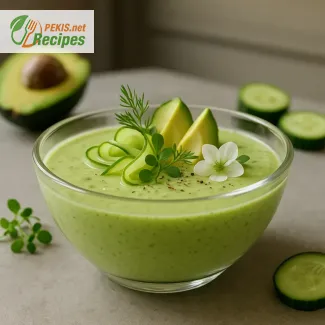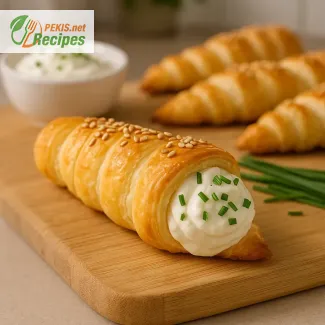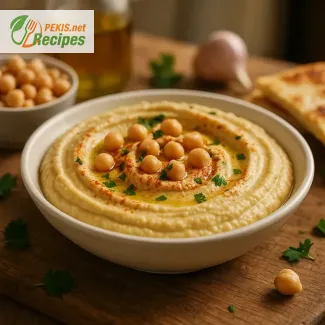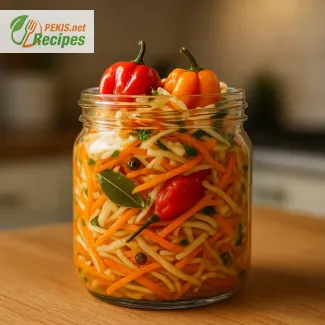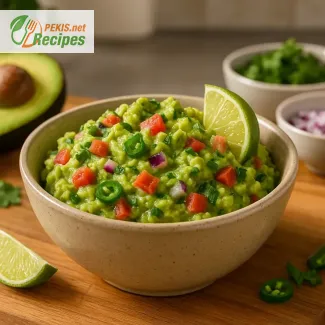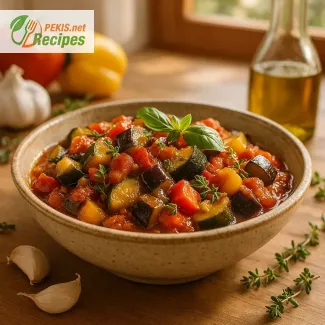
A vibrant summer salad with grilled stone fruit and creamy burrata
A delightful harmony of textures and flavors in every bite
When it comes to fresh summer salads, few combinations are as satisfying and elegant as a Grilled Peach Burrata Salad with Balsamic Glaze. This radiant dish celebrates the best of seasonal produce by bringing together juicy, caramelized peaches, creamy burrata cheese, and peppery arugula, all tied together with a rich balsamic reduction that adds depth and a hint of sweetness. It’s not just a side dish—it’s an elevated experience that balances savory and sweet, soft and crunchy, warm and cool.
What makes this salad stand out is the careful contrast between the smoky char of grilled peaches and the milky softness of burrata. The peaches, lightly brushed with oil and kissed by the heat of the grill, intensify in flavor as their natural sugars caramelize. Their slight crispness on the outside yields to a juicy, tender interior that pairs exquisitely with the lusciously creamy burrata. Burrata, known for its soft shell and rich, runny center, brings a luxurious mouthfeel that enhances every ingredient it touches.
Underneath this pairing lies a bed of vibrant greens, most often fresh arugula or baby spinach, chosen for their peppery bite and delicate crunch. These greens provide not only visual vibrancy but a flavor contrast that supports the sweetness of the peaches and the richness of the cheese. A light drizzle of extra virgin olive oil, along with sea salt and freshly cracked pepper, heightens the natural flavors without overpowering them.
Then comes the balsamic glaze—the element that binds it all together. Reduced until thick and glossy, this dark elixir adds an earthy tang that balances the sweetness of the peaches and enhances the complexity of the dish. Just a few artful swirls over the top, and suddenly the salad becomes something to linger over. Its glossy finish and intensely fruity acidity awaken the palate and lend visual drama to the plate.
To make the salad even more dynamic, many choose to incorporate crunchy elements like toasted almonds or pistachios, or a few fresh basil leaves for an herbal lift. Thinly sliced red onions can offer a bit of sharpness, while prosciutto adds a salty, savory depth for those seeking an even more decadent experience. However, even in its most minimal form—just grilled peaches, burrata, greens, and glaze—this salad commands attention.
This dish is ideal for warm-weather dining, whether you're hosting a summer brunch, preparing a light dinner, or looking for a show-stopping appetizer that brings elegance without effort. Its colors are bold, its components are simple, and its flavors are unforgettable. There’s a reason why peach and burrata salads have become a staple on modern menus—they’re visually stunning, easy to prepare, and endlessly customizable.
Moreover, this salad reflects a growing trend in modern cuisine: dishes that celebrate fresh ingredients and minimal intervention. The peaches don’t need seasoning beyond a brush of oil, the burrata needs no enhancement, and the greens are best when left pure. The real magic lies in the quality of each component and how they come together with just a few thoughtful touches.
Whether served as a standalone lunch or the elegant first course of a larger meal, this Grilled Peach Burrata Salad evokes the feeling of sun-soaked terraces, late afternoon picnics, and shared plates that bring people together. Every forkful delivers a balance of sweet fruitiness, creamy indulgence, and savory depth, making it one of those rare dishes that feels both comforting and sophisticated.
It’s no wonder that burrata peach salads have seen a surge in popularity. Their visual appeal and flavor complexity make them ideal for those who seek seasonal recipes that are both simple and luxurious. With just a handful of high-quality ingredients and a few minutes on the grill, you can create a salad that looks and tastes like it came from a fine dining kitchen.
- Prepare the peaches
Wash the peaches thoroughly and cut each one in half, removing the pit. Slice each half into 3 or 4 wedges. Lightly brush the peach slices with extra virgin olive oil on all sides. - Grill the peaches
Preheat a grill or grill pan over medium-high heat. Once hot, place the peach slices cut-side down and grill for 2–3 minutes per side until grill marks form and the fruit is slightly softened but not mushy. Remove and set aside to cool slightly. - Prepare the greens
Rinse and dry the arugula. Arrange it evenly across a large serving platter or individual plates. - Assemble the salad
Tear the burrata into rustic chunks and place them over the bed of arugula. Distribute the grilled peach slices evenly across the salad. Sprinkle with freshly chopped basil leaves. - Add toppings
If using, scatter thinly sliced red onions and chopped toasted pistachios on top for added crunch and flavor depth. - Season and finish
Drizzle the salad with balsamic glaze and a bit of extra virgin olive oil. Season lightly with sea salt and freshly ground black pepper to taste. - Serve immediately
Serve the salad while the peaches are still warm and the burrata is creamy and soft. Best enjoyed fresh.
Elevating the Classic Peach Burrata Salad with Modern Twists
Creative ways to refine flavor, texture, and presentation in this seasonal favorite
The Grilled Peach Burrata Salad is already a show-stopping dish thanks to its vibrant visual appeal, rich contrasts in flavor, and fresh ingredients. However, even the most beloved traditional recipes can be enhanced with thoughtful modifications that introduce new layers of taste and nutritional benefits. By making slight tweaks to components like the fruit, cheese, greens, and garnish, we can customize the salad to better reflect personal preferences or dietary goals—without compromising on its original charm.
Exploring new dimensions with fruit variations
Peaches are the star of this salad, and while ripe grilled peaches provide a sweet and smoky profile, other stone fruits can offer surprising depth. Try using nectarines for a firmer bite or plums for a more tart and juicy contrast. For a touch of tropical sweetness, grilled mango slices work beautifully, especially when balanced with fresh lime zest. These substitutions can maintain the fruit-forward foundation of the dish while adding complexity and a unique seasonal touch.
Choosing the right burrata or cheese alternative
Burrata is known for its rich, creamy center and soft exterior, making it an indulgent pairing for grilled fruit. However, for those seeking a lighter or dairy-free version, you can substitute with fresh mozzarella, vegan cashew cheese, or even creamy goat cheese. Goat cheese offers a tangier profile that plays well against sweet fruit, while a plant-based alternative can cater to vegan diets without sacrificing the creamy mouthfeel.
Those watching their fat intake can opt for part-skim mozzarella or light ricotta, though these may slightly alter the texture. Whipping the ricotta with lemon zest and a dash of olive oil can help replicate burrata’s signature creaminess and richness while keeping calories lower.
Greens that enhance more than just color
Arugula is a common choice in peach burrata salads due to its peppery sharpness, but not everyone enjoys its assertiveness. For a milder base, try mixing in baby spinach, mâche (lamb’s lettuce), or butter lettuce. These greens offer a softer bite and a slightly sweet flavor that lets the peaches and cheese shine more prominently. If texture is a priority, consider a blend that includes radicchio or frisée for added bitterness and crunch.
Each green brings different micronutrients to the plate as well—spinach boosts iron and folate, while arugula contributes more calcium and vitamin K. Tailoring the salad base in this way supports both flavor enhancement and nutritional diversity.
Upgrading your glaze and dressings
While traditional balsamic glaze adds richness and acidity, you can experiment with other reduction sauces for elevated flavor. A honey-lavender glaze or fig balsamic reduction introduces floral or fruity depth. For a citrus twist, reduce orange juice with honey and a splash of vinegar into a sticky, tangy glaze that pairs wonderfully with both fruit and cheese.
Alternatively, if you're looking to cut down on sugars, a dressing of lemon juice, extra virgin olive oil, and fresh thyme can lend brightness and complexity without adding concentrated sweetness.
Garnishes that build texture and contrast
The original recipe often includes pistachios and basil. While they complement the dish beautifully, there's room to be playful. Substitute pistachios with toasted almonds, pine nuts, or candied walnuts for a different textural and flavor experience. To intensify the savory contrast, sprinkle crumbled prosciutto or crispy pancetta for a salty, meaty touch that elevates the salad from light appetizer to satisfying main course.
If you're keeping it plant-based, toasted pumpkin seeds or sunflower seeds deliver a pleasant crunch and nuttiness. Don’t forget the herbs—fresh tarragon, mint, or even chervil can subtly alter the dish’s aromatic profile.
Avoiding common preparation mistakes
One of the biggest missteps in preparing this salad is overcooking the peaches. Grilled fruit should have visible char marks and softened flesh but must not turn mushy. Preheat the grill and cook each side only briefly—2 to 3 minutes is usually enough. Letting the burrata sit too long at room temperature can also lead to separation and a watery salad, so timing and freshness are key.
Using a store-bought balsamic glaze that’s too sweet or artificial can overwhelm the other ingredients. Opt for authentic, high-quality balsamic vinegar reduced at home for better balance and control. Lastly, always season the greens lightly—underdressed salad can taste flat, while overseasoned greens overpower the delicate cheese and fruit.
Healthier alternatives without sacrificing flavor
For those seeking a healthier take, small changes can make a big difference. Choose low-fat cheese, skip the glaze, or drizzle with just a teaspoon of cold-pressed oil. You can add quinoa or lentils to the base to make the salad more filling and rich in plant protein. Swapping out high-sugar balsamic reductions with fresh citrus juices also helps keep the dish diabetes-friendly.
Don’t forget to include colorful vegetables—roasted beets, thinly sliced fennel, or grilled zucchini add variety and boost the salad’s nutritional content while preserving its summery character.
Why homemade versions are better
Making this salad at home gives you full control over the freshness of ingredients, portion sizes, and seasoning intensity. Store-bought versions often use overly sweet dressings, inferior quality cheese, or under-ripe fruit. At home, you can prioritize organic produce, select cheeses to suit your dietary needs, and enjoy the meal fresh, rather than after it’s been sitting in a container for hours.
Moreover, grilling peaches in your own kitchen fills the space with a sweet, caramel aroma that enhances the eating experience. Serving the salad while the burrata is just beginning to ooze creates a sensory contrast that’s difficult to replicate outside a home setting.
Unlocking the full potential of this seasonal dish
By understanding how each element contributes to the dish—sweet, salty, creamy, crunchy—you can fine-tune your version to match the season, occasion, or health goals. The beauty of this salad lies in its versatility. Whether you're elevating it with gourmet cheese, boosting the nutrients with leafy greens, or turning it into a hearty lunch with grains, every adjustment brings something new to the table while honoring the original inspiration.
Allergens and gluten presence
Contains: Milk (burrata), Tree nuts (pistachios – optional)
Gluten: This recipe is naturally gluten-free.
Substitution tips for allergens and gluten
- Replace burrata with dairy-free cashew cheese or almond-based cheese to make the dish dairy-free.
- Omit pistachios or substitute with sunflower seeds if tree nuts are a concern.
- No gluten-containing ingredients are used, but always check labels of balsamic glaze to ensure it's gluten-free.
- Vitamin A: 780 µg – Supports vision and immune health
- Vitamin C: 22 mg – Contributes to collagen production and immune defense
- Vitamin K: 65 µg – Important for bone health and blood clotting
- Calcium: 145 mg – Essential for bone strength and nerve transmission
- Potassium: 480 mg – Helps regulate blood pressure and muscle function
- Magnesium: 38 mg – Supports energy metabolism and muscle relaxation
- Iron: 1.6 mg – Vital for red blood cell formation
- Beta-carotene: 1.3 mg – Aids skin health and combats oxidative stress
- Polyphenols (from balsamic glaze and peaches): ~150 mg – Promote cardiovascular protection and reduce inflammation
- Lutein + Zeaxanthin (from arugula): ~1.2 mg – Support eye health and reduce risk of macular degeneration
